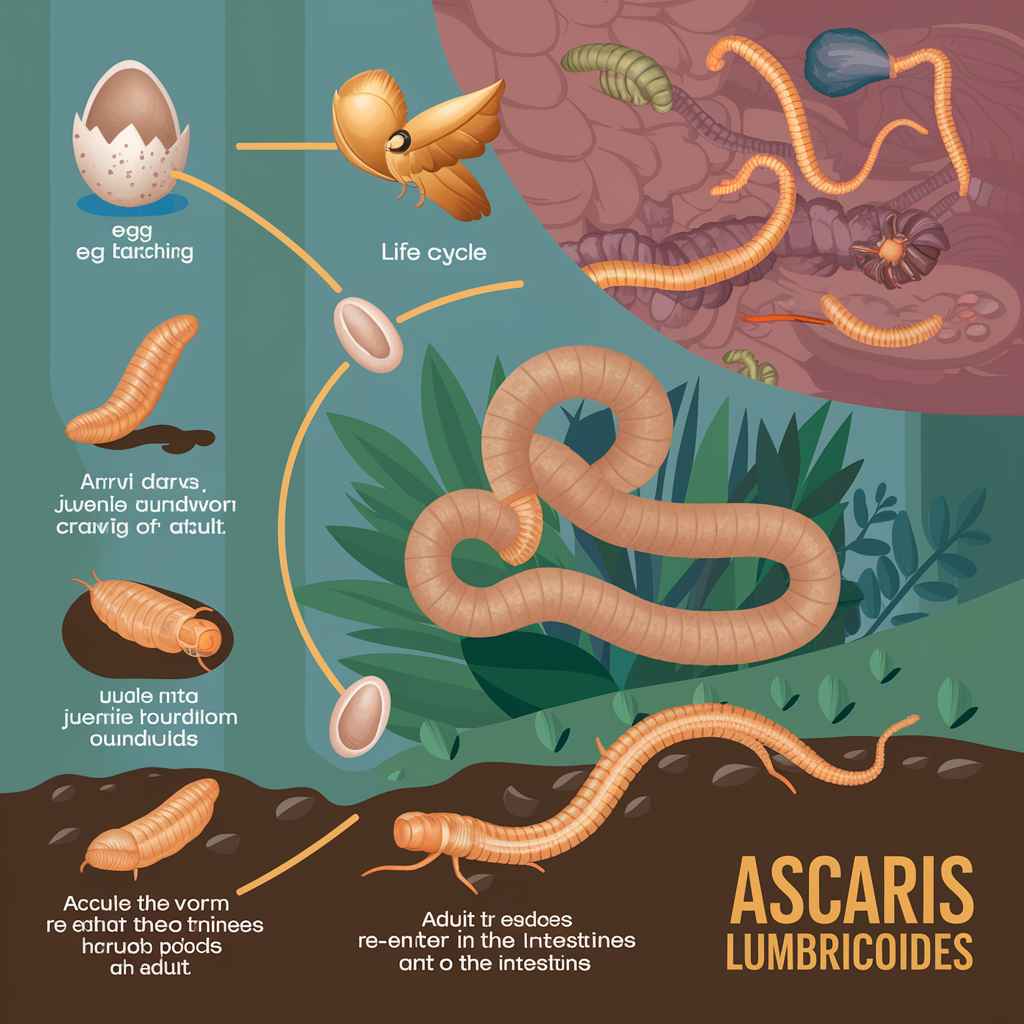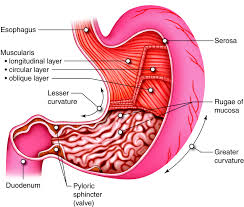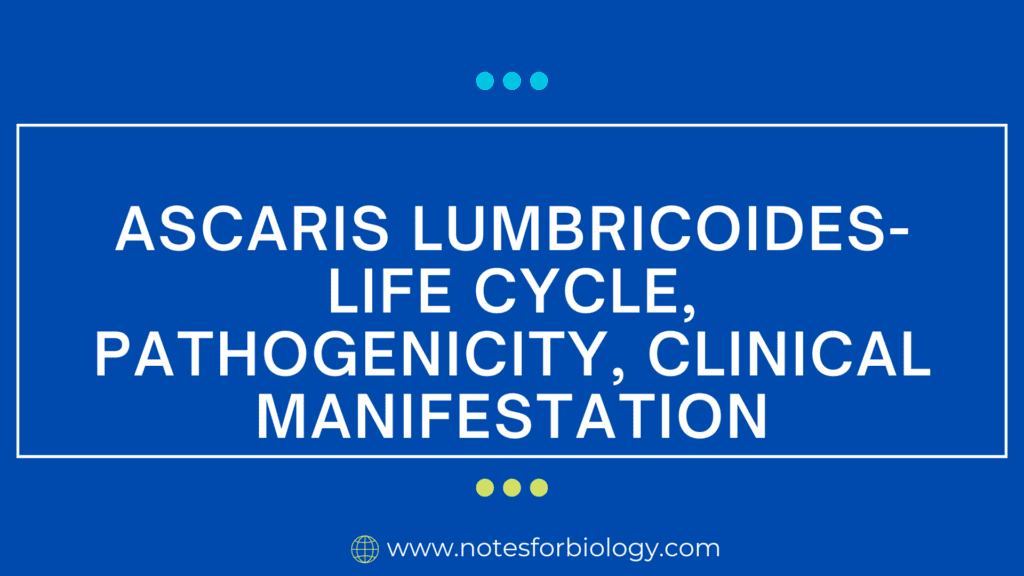Ascaris lumbricoides is a roundworm from the phylum Nematoda. It is one of the most prevalent and widespread intestinal parasites in humans, resulting in ascariasis. Ascaris lumbricoides infects the small intestine in humans and other species.
Table of Contents
Ascaris lumbricoides
Ascaris lumbricoides is a parasitic roundworm that lives in the human gastrointestinal tract. It belongs to the phylum Nematoda and is one of the most common parasites in people globally. Ascaris lumbricoides infections arise when people consume the parasite’s eggs, which are frequently found in polluted soil, water, or food. Once consumed, the eggs hatch in the small intestine, releasing larvae that travel through numerous tissues, including the liver and lungs, before growing into adult worms in the small intestine. Adult worms can cause a variety of symptoms, including abdominal pain, bloating, diarrhea, and respiratory issues including coughing and breathing. Heavy infections can cause problems like intestinal blockage, malnutrition, and impaired
Life cycle of Ascaris lumbricoides

Egg Ingestion
The life cycle begins when individuals consume Ascaris lumbricoides eggs, which are commonly found in polluted soil, water, or food.
Hatching in the Intestine
Once consumed, the eggs hatch in the small intestine and release larvae.
Larval Migration
The larvae pass through the intestinal wall and into the bloodstream, where they migrate to numerous organs such as the liver and lungs.
Respiratory Phase
The larvae enter the lungs through the alveolar walls and ascend the respiratory tract. They are then coughed up, ingested, and absorbed into the small intestine.
Maturation
Within a few months, the larvae in the small intestine turn into adult worms.
Reproduction
In the small intestine, adult male and female worms mate, and the female lays a huge number of eggs. The infected person excretes these eggs in their feces.
Environment Pollution

After being expelled, Ascaris lumbricoides eggs pollute the environment, especially the soil. For several years, they can survive in the soil, waiting to be consumed by a different host and start a fresh infection cycle.
Pathogenicity of Ascaris lumbricoides
Mechanical Obstruction
Severe Ascaris lumbricoides infestations may cause the gastrointestinal tract to become mechanically obstructed. Adult worms have the ability to group together and create masses that obstruct the intestines, resulting in symptoms including bloating, abdominal pain, and possibly fatal intestinal obstructions.
Malnutrition and Growth Stunting
Ascaris lumbricoides infections can obstruct the intestines’ ability to absorb nutrients, which can result in malnutrition, especially in young children. Prolonged infections can have an adverse effect on general health and wellbeing by causing growth retardation, delayed physical development, and cognitive impairment.
Respiratory Symptoms
Ascaris lumbricoides larvae migrate through the lungs during the larval migration phase of their life cycle. This can result in respiratory symptoms such coughing, wheezing, and disease similar to pneumonia. Respiratory distress and problems can arise during this pulmonary phase of infection, particularly in individuals with underlying respiratory conditions.
Clinical Manifestations of Ascaris lumbricoides
Asymptomatic Infection
Asymptomatic Ascaris infections are common, especially in people with modest worm burdens or those who have already been exposed to the parasite. In endemic areas, asymptomatic carriers might nevertheless contribute to the spread of infection by excreting Ascaris eggs in their feces.
Gastrointestinal Symptoms

stomach Pain: Adult worm irritation in the intestines often results in mild to moderate stomach pain. Diffuse or localized pain is possible; it usually occurs in the periumbilical or epigastric areas.
Vomiting and Nausea: Some infected people may go through periods of vomiting and nausea, particularly if there is a partial blockage or severe intestinal inflammation.
Diarrhea or Constipation: Bowel habit changes might lead to either diarrhea or constipation. Intestinal inflammation can produce diarrhea, whereas partial blockage from worms might cause constipation.
Respiratory Symptoms (Pulmonary Phase)
Cough: Those who are infected may experience a chronic dry cough as the larvae migrate through the lungs. Coughing facilitates the removal of ingested larvae from the respiratory system.
Wheezing and Breathlessness: Larvae migration can occasionally cause wheezing and breathing difficulties, particularly in those who already have respiratory diseases such asthma or chronic obstructive pulmonary disease (COPD).
Nutritional Deficiencies and Growth Impairment
Malnutrition: A long-term Ascaris infection can cause the intestines to fail in absorbing nutrients, which can result in malnutrition. Given that it results in stunted growth, weight loss, and delayed development in children, this is especially alarming.
Anemia: Iron-deficiency anemia, which is marked by weakness, pale complexion, weariness, and shortness of breath, can be brought on by a chronic loss of blood from intestinal injury brought on by adult worms.
Complications
Intestinal Obstruction: Adult worm infections can induce mechanical obstruction of the intestines, resulting in severe stomach pain, distention, and vomiting. Complete occlusion is uncommon but potentially fatal.
Intestinal Perforation: In severe situations, adult worms can cause ulcers and perforation of the intestinal wall, leading in peritonitis, an acute abdominal emergency characterized by severe pain, fever, and shock.
Frequently Asked Question(FAQ)
What is Ascaris lumbricoides?
Ascaris lumbricoides is a type of parasitic roundworm that lives in the human intestine. It is one of the most common and pervasive parasites, especially in areas with inadequate sanitation and hygiene measures. Ascaris lumbricoides belongs to the Nematoda phylum, specifically the Ascarididae family.
What is Maturation?
In biology, maturation refers to the process of development and growth that leads to a fully functional, mature state. It entails a series of coordinated alterations and transformations at the cellular, tissue, organ, and organismal levels, culminating in the development of adult features and functionality.
Related Article




